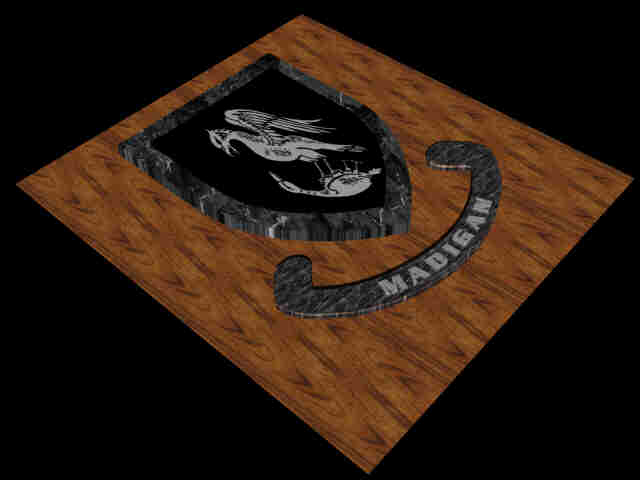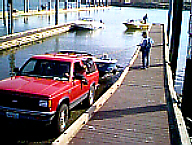 I stood off to the side when it came time to
launch the boat. It again, was a smooth simple
operation with each doing his part without interfering
with the other. What a team! The day was a blustery
one with a good 30 knot wind causing small white caps
on the otherwise tranquil river entrance. We picked a
place a mile or so in from where it converged with the
Pacific. Bill explained that getting too close to the
convergence point was bad as the current was so strong
it would push the floats under the surface. Although
the small boat rocked in the waves,
I stood off to the side when it came time to
launch the boat. It again, was a smooth simple
operation with each doing his part without interfering
with the other. What a team! The day was a blustery
one with a good 30 knot wind causing small white caps
on the otherwise tranquil river entrance. We picked a
place a mile or so in from where it converged with the
Pacific. Bill explained that getting too close to the
convergence point was bad as the current was so strong
it would push the floats under the surface. Although
the small boat rocked in the waves,
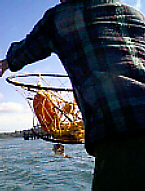 Bill moved about
casting the nets into the river with great skill,
checking that the rings sank in concentric order.
Sometimes a slight yank on the tether was needed.
Soon all three of the floats bobbed in the ever
increasing breeze. Ken had negotiated the boat along
a straight line while Bill had thrown the nets. Now
Ken turned in a slow wide arc, until we had arrived
just below the first net heading in the same line. As
we passed each buoy Bill would lean over the edge of
the rocking boat to catch the bobbing buoy. He missed
only twice during the entire operation. As soon as he
had a firm grasp on the tether, Ken would start
yelling “Is it heavy, Pull faster, You’re too slow”,
and then laugh. If the net was empty, which was rare,
Ken would start with “See you let them all crawl out.”
If it was full, which was more often the case, Ken
would be shouting, “Any keepers?”,
Bill moved about
casting the nets into the river with great skill,
checking that the rings sank in concentric order.
Sometimes a slight yank on the tether was needed.
Soon all three of the floats bobbed in the ever
increasing breeze. Ken had negotiated the boat along
a straight line while Bill had thrown the nets. Now
Ken turned in a slow wide arc, until we had arrived
just below the first net heading in the same line. As
we passed each buoy Bill would lean over the edge of
the rocking boat to catch the bobbing buoy. He missed
only twice during the entire operation. As soon as he
had a firm grasp on the tether, Ken would start
yelling “Is it heavy, Pull faster, You’re too slow”,
and then laugh. If the net was empty, which was rare,
Ken would start with “See you let them all crawl out.”
If it was full, which was more often the case, Ken
would be shouting, “Any keepers?”,
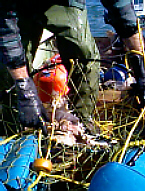 Bill would counter
with “Maybe.” As he would reach in with his gloved
hand to pick up each crab. Little ones went over the
side without ceremony. Big ones got turned over. The
shell casing design on the belly of a Dungeness crab
identifies it as either male or female. Females go
back regardless of size. Of the remaining males,
those over 5 1/2 inches across from shell corner to
shell corner are “keepers” The size differs in each
state, with Oregon allowing the smallest. However in
most cases, measurements were not required. The hours
sped by as Bill tirelessly pulled in net after net
Bill would counter
with “Maybe.” As he would reach in with his gloved
hand to pick up each crab. Little ones went over the
side without ceremony. Big ones got turned over. The
shell casing design on the belly of a Dungeness crab
identifies it as either male or female. Females go
back regardless of size. Of the remaining males,
those over 5 1/2 inches across from shell corner to
shell corner are “keepers” The size differs in each
state, with Oregon allowing the smallest. However in
most cases, measurements were not required. The hours
sped by as Bill tirelessly pulled in net after net
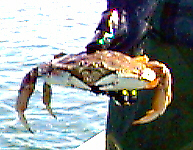 dumping crabs back into the river and keeping one or
two each time. Then it was time for lunch. We threw
the nets overboard, and headed for shore and a snack.
It was now my turn to drive. The wind had kicked up
quite a breeze and the swells threatened to pass over
the gunwale. It took several passes before I learned
the proper approach to the buoys. Bill was patient as
a teacher and Ken gave me nothing but heck, in the
warm happy way he had conducted himself most of the
afternoon. I had returned most of his jabs with
threats of negotiating a wave into his lap. He
jokingly zipped his windbreaker up over his head and
looking out through the small opening with on eye,
challenged me “Go ahead sonny.” Being between buoys
at the time, I had been watching him and failed to
notice that the boat had swung head up into the
swells. The recollection of something very large right
in front of me caused my head to jerk to the front
just in time to catch a large swell as it passed over
the bow and dumped about 10 gallons of water on the
two of us. Bill howled with glee as Ken sputtered
under his breath and I cursed the parentage of all
waves in general.
dumping crabs back into the river and keeping one or
two each time. Then it was time for lunch. We threw
the nets overboard, and headed for shore and a snack.
It was now my turn to drive. The wind had kicked up
quite a breeze and the swells threatened to pass over
the gunwale. It took several passes before I learned
the proper approach to the buoys. Bill was patient as
a teacher and Ken gave me nothing but heck, in the
warm happy way he had conducted himself most of the
afternoon. I had returned most of his jabs with
threats of negotiating a wave into his lap. He
jokingly zipped his windbreaker up over his head and
looking out through the small opening with on eye,
challenged me “Go ahead sonny.” Being between buoys
at the time, I had been watching him and failed to
notice that the boat had swung head up into the
swells. The recollection of something very large right
in front of me caused my head to jerk to the front
just in time to catch a large swell as it passed over
the bow and dumped about 10 gallons of water on the
two of us. Bill howled with glee as Ken sputtered
under his breath and I cursed the parentage of all
waves in general.
